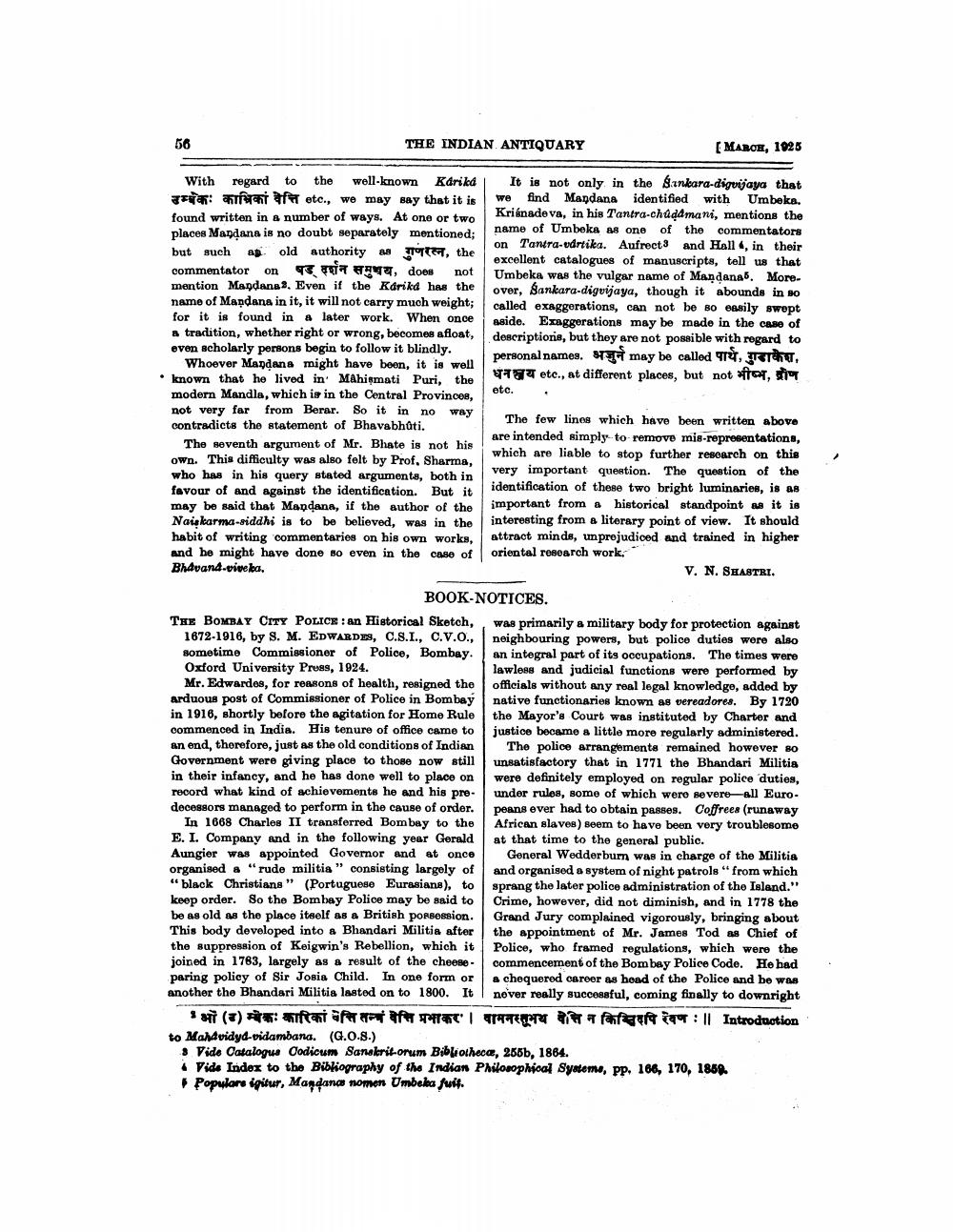________________
56
THE INDIAN ANTIQUARY
With regard to the well-known Kariká : aferent af etc., we may say that it is found written in a number of ways. At one or two places Mandana is no doubt separately mentioned; but such as old authority as te, the षड् दर्शन समुचय, does not
commentator on mention Mandanas. Even if the Kárika has the name of Mandana in it, it will not carry much weight; for it is found in a later work. When once a tradition, whether right or wrong, becomes afloat, even scholarly persons begin to follow it blindly.
Whoever Mandana might have been, it is well known that he lived in Mahismati Puri, the modern Mandla, which is in the Central Provinces, not very far from Berar. So it in no way contradicts the statement of Bhavabhuti.
The seventh argument of Mr. Bhate is not his own. This difficulty was also felt by Prof, Sharma, who has in his query stated arguments, both in favour of and against the identification. But it may be said that Mandana, if the author of the Naiskarma-siddhi is to be believed, was in the habit of writing commentaries on his own works, and he might have done so even in the case of Bhavana-viveka,
[MARCH, 1925
It is not only in the Sankara-digvijaya that we find Mandana identified with Umbeka. Kriánade va, in his Tantra-chudamani, mentions the name of Umbeka as one of the
commentators on Tantra-vdrtika. Aufrect3 and Hall 4, in their excellent catalogues of manuscripts, tell us that Umbeka was the vulgar name of Mandana5. Moreover, Sankara-digvijaya, though it abounds in so called exaggerations, can not be so easily swept aside. Exaggerations may be made in the case of descriptions, but they are not possible with regard to personal names. अज्जुर्न may be called पार्थ, गुडाकेश, धनञ्जय etc., at different places, but not भीष्म, द्रोण
etc.
THE BOMBAY CITY POLICE: an Historical Sketch, 1672-1916, by S. M. EDWARDES, C.S.I., C.V.O., sometime Commissioner of Police, Bombay. Oxford University Press, 1924.
Mr. Edwardes, for reasons of health, resigned the arduous post of Commissioner of Police in Bombay in 1916, shortly before the agitation for Home Rule commenced in India. His tenure of office came to an end, therefore, just as the old conditions of Indian Government were giving place to those now still in their infancy, and he has done well to place on record what kind of achievements he and his predecessors managed to perform in the cause of order.
In 1668 Charles II transferred Bombay to the E. I. Company and in the following year Gerald Aungier was appointed Governor and at once organised a "rude militia" consisting largely of "black Christians" (Portuguese Eurasians), to keep order. So the Bombay Police may be said to be as old as the place itself as a British possession. This body developed into a Bhandari Militia after the suppression of Keigwin's Rebellion, which it joined in 1783, largely as a result of the cheeseparing policy of Sir Josis Child. In one form or another the Bhandari Militia lasted on to 1800. It
The few lines which have been written above are intended simply to remove mis-representations, which are liable to stop further research on this very important question. The question of the identification of these two bright luminaries, is as important from a historical standpoint as it is interesting from a literary point of view. It should attract minds, unprejudiced and trained in higher oriental research work.
V. N. SHASTRI.
BOOK-NOTICES.
was primarily a military body for protection against neighbouring powers, but police duties were also an integral part of its occupations. The times were lawless and judicial functions were performed by officials without any real legal knowledge, added by native functionaries known as vereadores. By 1720 the Mayor's Court was instituted by Charter and justice became a little more regularly administered. The police arrangements remained however so unsatisfactory that in 1771 the Bhandari Militia were definitely employed on regular police duties, under rules, some of which were severe-all Europeans ever had to obtain passes. Coffrees (runaway African slaves) seem to have been very troublesome at that time to the general public.
General Wedderburn was in charge of the Militia and organised a system of night patrols "from which sprang the later police administration of the Island." Crime, however, did not diminish, and in 1778 the Grand Jury complained vigorously, bringing about the appointment of Mr. James Tod as Chief of Police, who framed regulations, which were the commencement of the Bombay Police Code. He had a chequered career as head of the Police and be was never really successful, coming finally to downright वामनस्तुभय वेति न कितिदपि रेवण: || Introduction
'भों (उ) बेकः कारिकां वेत्ति तन्त्रं वेत्ति प्रभाकर ।
to Mahavidyd-vidambana. (G.O.8.)
3 Vide Catalogue Codicum Sanskrit-orum Bibliothecæ, 255b, 1864.
Vide Index to the Bibliography of the Indian Philosophical Systems, pp. 166, 170, 1859. Populare igitur, Mandance nomen Umbeka fuit.




